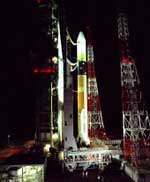
Image credit: JAXA
The Japanese space program suffered a setback on Saturday when a booster failed to detach from an H2-A rocket. Operators forced the rocket to self destruct, as it wouldn’t be able to reach its intended orbit with the additional weight of the booster. The rocket was carrying two spy satellites which were intended to keep an eye on North Korea’s rocket program. Prior to Saturday’s failure, the H2-A rocket had launched five consecutive times safely, but insurance companies will probably require six safe launches before covering commercial launches.
The Japan Aerospace Exploration Agency (JAXA) launched the H-IIA Launch Vehicle No 6 (H-IIA F6) with the information gathering satellite #2 (IGS) onboard from the Tanegashima Space Center at 13:33 on November 29, 2003 (Japan Standard Time). However, the vehicle failed to jettison one of its two Solid Rocket Boosters (SRB-As). H-IIA F6 was consequently destroyed by a destruction command from the ground at 13:43:53 as the vehicle did not gain enough height and speed due to the failure.
JAXA has established an accident investigation team led by President Yamanouchi and is investigating the cause of the accident. JAXA will provide additional information when it becomes available.
